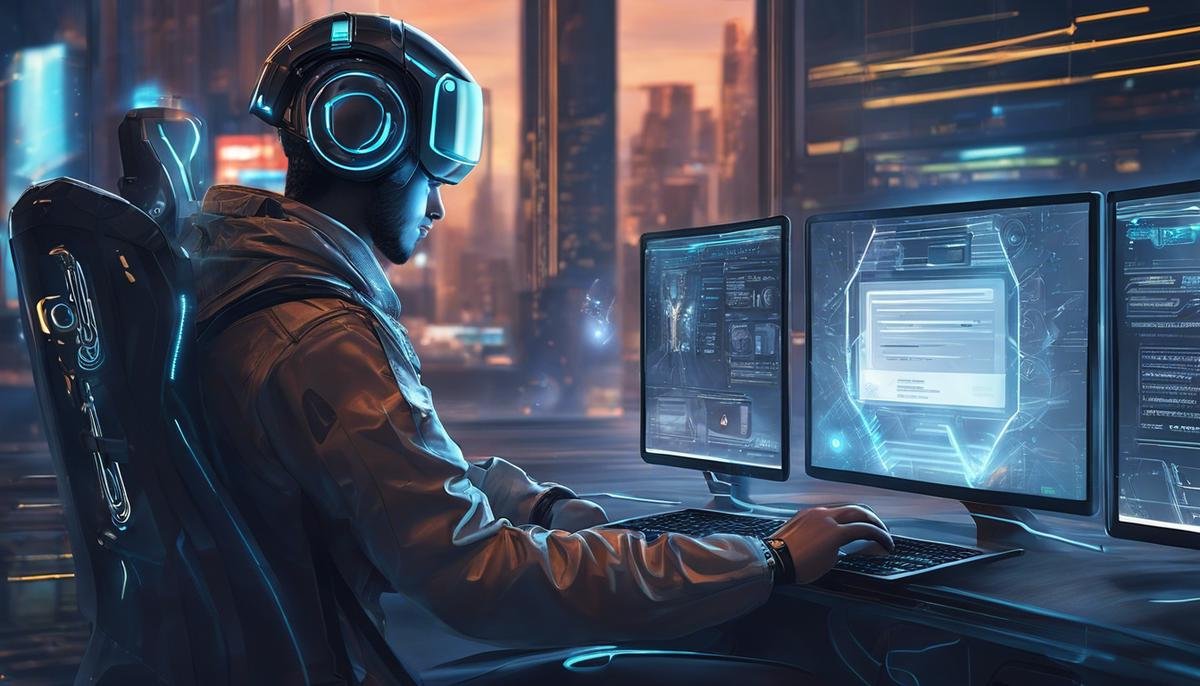In the modern age of technology, there is an emerging AI entity that is rapidly revolutionizing various sectors of industry – the chatbot. Diving into the intricate world of artificial intelligence and machine learning, this breakthrough technology has shaped a new narrative in customer interaction and service provision. Our journey takes us through the inner workings of chatbot technology, helping us unravel the nuts and bolts of this potent robot. We then move on to highlight real-life applications, demonstrating how chatbots are transforming different sectors worldwide. We also shed light on the pros and cons of this technology, providing a balanced perspective for informed decision-making. Finally, we cast our eyes into the future, envisioning what lies ahead in the exciting world of chatbots.
Understanding the Chatbot Technology
The astonishing rate at which chatbot technology is advancing can be attributed to the constant evolution in artificial intelligence and machine learning techniques. Through this piece, we will discuss some of the key factors that are propelling the faster growth of chatbot technology – AI and machine learning advancements, increasing demand in customer service, rising use of mobile messaging apps, and cost-effectiveness.
First and foremost, the most significant driver for the swift development of chatbot technology is improvements in artificial intelligence and machine learning. With AI and Machine Learning advancements, chatbots are becoming smarter as they learn through algorithms and past interactions. This evolution enables them to understand, learn, and predict customer behavior better, thus making chatbot responses increasingly accurate and context-sensitive, which indeed heightens customer experiences.
Over time, customer service demands have altered remarkably, which subsequently led to the rise of chatbot technology. Modern users crave immediate answers and personalized experiences, and that is exactly what chatbots offer—a swift and personalized response to user queries. Businesses are adopting chatbot technology as they provide round-the-clock, unbroken support to the consumers, thereby enhancing customer relationships and engagement.
A dramatic increase in the use of mobile messaging apps such as WhatsApp, Facebook Messenger, and WeChat has also been observed. These apps become the prime platform for businesses to interact with their customers—allowing them to provide personalized and immediate customer service on a platform that customers already use daily—and therefore, encourage the adoption of chatbot technology.
Lastly, chatbots are cost-effective, thus attracting businesses to integrate them into their customer service. Opting for human support round the clock might dig a deeper hole in a company’s pocket, but chatbots do not come with such constraints or overhead costs. Once designed and implemented, they provide relentless service—you only need to maintain and update them occasionally.
In conclusion, increasing customer service demands, rising use of mobile messaging apps, advancements in AI and machine learning, and cost-effectiveness propel the advancement of chatbot technology at such a rapid pace. With these contributing factors, it’s not much of a stretch to say that the day isn’t far when we can actually mimic a complete human-like conversation with bots. Stay tuned for more innovation and developments in this field.

Integration of Chatbots in Different Sectors
Harnessing the Power of Chatbots for Industry Automation
Companies across the board are going high-tech with chatbots. These industry warriors are fast, efficient, and forever fueled by the latest buzz in technology – a catalyst driving change in numerous sectors.
Healthcare, recognized for its life-saving interventions, frequently experiences bottlenecks in patient communication. No more. Chatbot’s instant-response and 24/7 availability are radically transforming patient management. Providing advice on minor health concerns, scheduling appointments, and delivering reminders for medication now have digital support, setting a new standard for patient-centric service.
Where money talks, financial institutions are tuning in to chatbots. Friendly bot-banking aids customers in tracking spending, making payments, and even suggesting personalized savings plans. They are the tellers of the digital age, offering consumers detailed account information without human intervention, creating a streamlined banking experience that is sure to revolutionize the industry.
Hoteliers and airline companies aren’t left behind either. Chatbots in the travel industry are becoming indispensable, delivering instant responses to customer inquiries, booking tickets, and providing seamless customer interfaces for hassle-free vacation planning.
Imagine trying to find the perfect office chair among thousands of options on an e-commerce site. No need for endless scrolling, a chatbot-powered site navigates you in the right direction. E-commerce giants are leveraging this technology for customized shopping experiences, providing product recommendations, processing orders, and even offering post-sales support making every purchase, a breeze.
Even the world of education is embracing chatbots. From administrative tasks like admissions and registrations to personalized tutoring, these digital tutors are paving the way for smart classrooms of the future.
Chatbots in Human Resources are stepping in as facilitators, managing repetitive tasks like scheduling interviews, answering common queries or onboarding newcomers. These robotic associates take the load off HR professionals, allowing them to delegate routine tasks in exchange for strategic decision-making.
In conclusion, chatbots are no longer just a ‘nice-to-have’ but an essential part of modern business operations across industries. They are providing an automation wave that will continue to profoundly impact industries leading us towards an economical and efficient future. The technology landscape waits with bated breath to see what’s next. And yes, chatbots, we are ready for the conversation.

Pros and Cons of Chatbots
The Potential Advantages and Drawbacks of Implementing Chatbots
Chatbots embody the futuristic ideas of automating responses and simplifying interactions with technology. However, despite the hype around them, it’s critical to understand the pros and cons they bring to various sectors including healthcare, finance, travel, e-commerce, education, and HR.
First, the advantages. Chatbots offer around-the-clock availability. Unlike humans, they don’t require breaks or sleep, and are able to answer queries and solve problems without delay any time of day. This perpetual accessibility can significantly enhance customer experience for industries which require constant interaction with users.
Moreover, chatbots possess the ability to manage multiple interactions simultaneously. In areas such as e-commerce and healthcare, where an influx of simultaneous inquiries is common, chatbots help handle this volume efficiently. This leads to an overall improvement in the response time and service quality offered by businesses.
Additionally, chatbots help in data collection for personalized experiences. They can analyze data from user interactions and tap into this invaluable resource to offer personalized responses and recommendations. For educational institutions and financial services, this implies custom-tailored interaction that resonates with each individual user.
Yet, every coin has two sides. Despite the numerous advantages of implementing chatbots, certain drawbacks call for attention as well. The lack of emotional intelligence in chatbots, for instance, could be a significant setback in sectors that require a touch of empathy and understanding, including healthcare and HR.
Furthermore, there’s the question of data security and privacy. With chatbots collecting heaps of data for analysis and personalization, the possibility of data breaches and misuse of private information cannot be disregarded. This issue extends across all sectors where chatbots come into play.
Another limitation is the inability of chatbots to handle complex queries. Although they are designed to tackle a wide range of inquiries, there are instances when human intervention becomes necessary. This minor shortcoming raises concerns about their efficacy in sectors like finance where precision and clarity are paramount.
Finally, one cannot ignore the challenges associated with the adoption and implementation of chatbots. Not all users may be comfortable dealing with bots. Some may find the learning curve steep or even unnerving. This situation is more likely to occur with the older demographic that is not as tech-savvy.
In conclusion, chatbots are like high-tech double-edged swords – revolutionizing various sectors while simultaneously offering new challenges. Gauging their potential against these challenges, it’s safe to say that the narrative of progress isn’t just about adoption, but also adaptation. The key is to strike a balance, integrating chatbots while maintaining the human touch where necessary, and never compromising on data security. This approach can ensure the train of progress barrels ahead without derailment.

Future of Chatbots
Chatbots have rapidly evolved over the years, and it’s clear that their potential is vast and untapped. You might be wondering what developments we can expect in the future with chatbots. Here’s the rundown on the exciting advancements that are on the horizon.
Personal voice assistants are growingly popular as they offer an effective way to interact with devices. Expect chatbots to become increasingly conversational, adapting more of the subtleties and complexities of human conversation. They will become more capable of understanding natural language, thanks to improvements in Natural Language Processing (NLP), a field focused on computer understanding of human speech. These advancements will see a rise in human-like bots that understand slang, idioms, and contextual clues.
The integration of chatbots with Internet of Things (IoT) devices is another exciting development. Smart home devices, wearables, and other IoT-enabled services will be able to interact and communicate with chatbots, benefiting the user with richer, more personalized experiences. Imagine a fridge bot that informs you of what’s inside, offers recipe suggestions based on available ingredients, or adds items to your shopping list when stocks run low.
Chatbots are anticipated to become proactive communicators. Currently, most chatbots are reactive, responding only when prompted by a user. But in the future, we can expect bots to initiate conversations based on remembered interactions and learned preferences. A proactive bot might send reminders without being asked, or suggest tasks based on past user activity.
Finally, augmented reality (AR) and chatbots will merge to create interactive, visual experiences. Imagine a chatbot that not only tells you about the weather forecast but also visualizes it using AR. Or a chatbot in an online shop that can superimpose clothes on a model, or on yourself, before you make a purchase.
In conclusion, the future of chatbots looks bright. Their potential is vast, and their development is accelerating. This can ultimately lead us to an era of automation so disruptive and efficient that it forever changes the way industries operate. The automation delivered by these advanced chatbots may very well be the next digital frontier.

Chatbot technology, while intricate and multi-faceted, has proven itself to be a game-changer time and again. Their diverse applicability, coupled with the continuous evolution in AI and machine learning, guarantees them a place in the foreseeable future. However, it is crucial to remain cognizant of both the benefits and limitations they present. With the understanding that their abilities are ever-improving yet may not fully replace the importance of human touch, it is up to us to utilize this tool judiciously. The narrative surrounding chatbots is an exciting one, full of possibility, innovation, and room for growth. As we advance technologically, we continue the journey towards seamless interaction with these robots, steadily breaking the barriers between humans and artificial intelligence.




